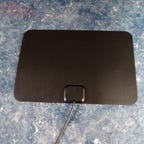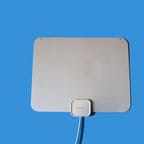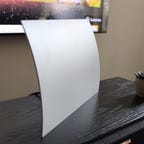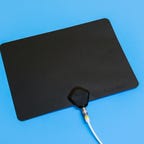Best TV Antenna for 2024
Get TV for free by installing an over-the-air antenna. Here are our top recommendations for the best indoor TV antennas.
What to consider
Coverage
In some areas, the TV signal may be nonexistent, but it doesn’t cost much to find out if an indoor antennas is for you.
Cost
The sweet spot for an indoor antenna is between $20 and $40.
Form factor
Most modern antennas are flat and window-mounted, and while you can opt for a large desktop model, the reception won’t be as good.
Cable
Look for a model that allows a detachable cable for added flexibility.
Our Picks

There has never been a better time to cut the cord and replace it with free TV. All you need to do before buying an affordable TV antenna is make sure that you're living in an area with a good signal. You don't even need to climb on your roof, as the best indoor antennas can be hung in a window.
An over-the-air, or OTA, antenna is great for live events such as sports and the evening news, plus the next evolution of OTA called NextGen TV. You can receive oodles of free content for as little as $25 shipped. Here are the best indoor antennas we've tested.
Detachable or captive cables. You choose!
What's the best overall TV antenna?
The best indoor antenna, based on dozens of CNET's tests, is the Mohu Leaf. It gathered the most stations in two different locations, and it can be yours for $35. Its sibling the Mohu Gateway was also a strong performer, and it has the advantage of tabletop use. If you're curious about the other options or are interested in features such as signal boosters or detachable cables, the following are the best indoor OTA antennas right now.
The best TV antennas we tested
The Mohu Leaf has undergone a recent upgrade -- a new look and some under-the-hood improvements -- and the results speak for themselves. The Leaf was the best antenna of our current crop -- beating out several more expensive models. It worked well in both of the testing environments and was able to receive the most channels. While the Channel Master Flatenna is almost half the price, the Mohu Leaf is undoubtedly worth the $15 upgrade.
My only quibble with the new Leaf is that it has lost the detachable coaxial cable in the process, and this means you'll need another cable and a male-to-male adaptor if you want a longer run to your TV.
Best tabletop antenna
Mohu Gateway
Maybe you don't have a window or an out-of-the-way wall you can stick an antenna on, and if so the Mohu Gateway can help. This tabletop antenna was neck and neck with its Leaf stablemate on both reception quality and price. What clinched it for us was that the Leaf was better suited for window placement, and with its integrated stand, the Gateway was understandably too awkward to be attached to a window. The reception on the Gateway was also worse when sitting on an AV unit instead of in a window, but if you have nowhere else to put an antenna than on a stand, the Gateway is the best choice.
Best antenna with amplifier
Gesobyte Amplified HD Digital TV Antenna -- Currently Out of Stock
In my years of testing antennas, the Gesobyte is still one of the only amplified models that has an attenuator switch. This feature allows flexibility which none of the other models have. Live close to a broadcast tower? Turn the switch to Low. If you live further away, switch it to High for an added signal boost.
Best budget TV antenna
Channel Master Flatenna 35/Duo
The Flatenna 35 has been upgraded with a removable cable since our original test. This antenna is great for people who simply want to test the waters, and while it wasn't the best performer, it's good for the money. If you want to find out if an indoor antenna is right for you, this is a great option. Notably, the Channel Master has had a $5 increase recently, which now means it's almost the same price as the leaders, and mostly loses its "budget" status.
Factors to consider when choosing a TV antenna
Coverage: In some places, the TV signal of some channels can be spotty or nonexistent due to faraway broadcast towers or obstructions that break up the signal. Also, unlike a live TV streaming service, OTA TV is usually restricted to a single television, and the broadcast signal from an OTA TV antenna won't work on phones or other devices. Unless you kick it up a notch with an OTA DVR with networking capabilities. Thankfully, indoor antennas are affordable enough that you can find out for yourself how strong your signal is without a big outlay.
Cost: The sweet spot for an indoor antenna is between $25 and $40, and if you’re paying any more than this, it’s likely for features you probably don’t need. If you're looking to spend more then consider installing an external antenna instead.
Form factor: Forget the old rabbit ears of days gone past, most modern antennas are flat and optimized to receive transmissions in a single plane. Almost every indoor antenna available is designed to be stuck to a surface like a wall or a window, and there are even clear models if you’re concerned about the antenna blocking your view. If you don’t want a long cable messing with your living space you can opt for a desktop standing model, but the tradeoff is that the reception won’t be as good.
Cable length: If your TV is close to the outer walls of your home then you won’t need a long run, but be aware that some of these models have short, attached cables and you may require more length. Look for a model that allows a detachable cable for added flexibility.
Amplifier: Nine times out of 10, a gain amplifier doesn’t offer any benefits and instead tends to muddy the reception waters -- while adding extra expense. While an amplifier can boost the signal of some stations, it can also overload ones that you already receive well. The net result is fewer channels overall. If you do opt for an amp try it with and without it connected to see which you like best. The best advice we can give is to buy the cheapest, non-amplified model you can and try it out first. If you get too few or no channels, then not even an amplified indoor antenna will change that. If that's the case, then an external antenna is the next best option.
Top antennas compared
| Price | No. of channels (NYC) | No. of channels (LA) | No. watchable test channels (out of 14) | |
|---|---|---|---|---|
| Antennas Direct Clearstream Eclipse | 40 | 104 | 70 | 11 |
| Btfdreem Smart TV Antenna -- Amplified | 29 | 81 | 104 | 11 |
| Channel Master Flatenna | 25 | 98 | 86 | 11 |
| Gesobyte Amplified HD Digital TV Antenna -- Low | 30 | 92 | 116 | 13 |
| Mohu Gateway | 35 | 104 | 128 | 11 |
| Mohu Leaf | 35 | 102 | 131 | 12 |
| Ultra Vizion HD Digital TV Antenna | 44 | 104 | 69 | 10 |
Other TV antennas we tested
- Antennas Direct ClearStream Eclipse: With its ankh-shaped and multidirectional reversible compact design, the ClearStream antenna is unique. This multi-directional antenna comes with sticky tabs for attaching it to your window, which is handy. If you need more signal oomph, a $20 antenna amplifier is available as well. A previous winner in this category, the Eclipse didn't perform as well as the Mohu units -- especially in our LA location.
- Ultra Vizion HD Digital TV Antenna: The Ultra Vizion is one of the most striking antennas we've seen thanks to its Perspex construction. It's large, and while it performed well when presented with a line of sight to a broadcast antenna it came last when tested in suburban LA.
The Btfdreem is a desktop antenna. Move along, please.
- Btfdreem Smart TV Antenna: Have you ever bought a product off Amazon that has a good rating, but you can't work out why? The Btfdreem is one of those. Sure it looks like a rocket ship, but that's all it has going for it. While it did OK in LA, it was one of the worst performers overall in this test.
- 1byOne Indoor Amplified HDTV Antenna: Last reviewed in 2021, the 1byOne includes a nonremovable coax cable, and at only 10 feet long, it may not work in some rooms where it cannot pick up a very weak signal. It was toward the bottom of the previous pack in terms of signal performance, but this indoor HDTV antenna was the only television antenna to pick up CBS from a TV tower at our Manhattan location.
The U Must Have Amplified HD Digital TV Antenna.
- U Must Have Amplified HD Digital TV Antenna: The U Must Have amplified antenna comes with a sticky pad on the back and a relatively long, although non-removable, lead at 18 feet. The included amplifier gives the antenna some flexibility and the product feels more solidly made overall than the 1byOne, although they performed similarly. Last reviewed in 2021.
How we test TV antennas
We tested seven different indoor antennas with prices ranging from $25 to $50 (all much less than the most basic cable TV service). The best TV antennas were able to pull in more channels than the others and delivered stronger, clearer TV signals, even on "problem" channels. Here are the seven TV antennas we looked at:
- Antennas Direct Clearstream: $40
- Btfdreem Smart TV Antenna: $29
- Channel Master Flatenna: $25
- Gesobyte Amplified HD Digital TV Antenna: $30
- Mohu Gateway: $35
- Mohu Leaf: $35
- Ultra Vizion HD Digital TV Antenna: $44
While most of the antennas were made by "name" manufacturers, the Gesobyte and the Btfdreem were chosen specifically because they were two of the highest-selling antennas on Amazon.
Much like real estate, how well a TV antenna works is based on location, location and location. We tested the antennas in two main places: in uptown Manhattan, New York with a line of sight to a broadcast tower six miles away, and in Reseda California, at least 10 miles from the closest tower. Depending on your own location, you might receive broadcasts from multiple antennas. Hills or large buildings in the way will affect the frequency range and reception of TV channels.
We situated each antenna in the same spot each time and connected it to the TiVo Edge, which gives signal strength data as well as a total channel count. We used two different metrics to determine which TV antenna performed best. The first was a raw measure of the number of channels it could detect, while the second involved several predetermined "problem channels." For these, we consulted a list of channels culled from various forums, for both testing areas, and gauged how well the antennas pulled in each channel.
The TiVo Edge is an OTA recorder for cord-cutters.
Our list of "problem" channels in Manhattan was WABC 7.1 (ABC), WNET 13.1 (PBS), WPIX 11.1 (CW -- Manhattan only) and WNJB 58.1 (PBS -- New Jersey only). In addition, we added popular channels CBS 2.1, WNBC 4 (NBC), and WNYW 5 (Fox). Meanwhile, we compiled a list of channels in LA including KCBS 2.1 (CBS), KNBC 4.1 (NBC), KTLA 5.1 (CW), KABC 7.1 (ABC), KTTV 11.1 (FOX), KCOP 13.1 (MyNetwork) and KCET 28.1 (PBS).
While the outcome will vary depending on where you live and how far you are from TV towers, in our tests the best-performing models received the greatest number of popular channels as well as local channels, radio broadcasts and Spanish-language stations.
Most of the TV antennas were based on the same rectangular design, but there was one important consideration: the cable. Did the antenna have a long, high-performance coaxial cable or, even better, a detachable one? You'll be sticking one of these in your window, which could be a long way from your TV, so longer is better.
It's worth noting that some of these antennas -- the Btfdreem, Gesobyte and the Ultra Vizion Plus -- included gain-boosting amplifiers. Based on our experiences in several locations over the years, amplifiers can affect signal strength in wildly unpredictable ways. The Ultra Vizion wouldn't work at all with the amp attached, while the others did. The numbers printed above are the best results with or without amplification. If you can't get TV reception with an indoor antenna, a gain amp may not actually help you, and in other cases, it could make your reception worse by overloading channels that already have a strong signal.
Several antennas in our list include a powered amplifier, but use thoughtfully, as these may actually make a strong signal worse.






